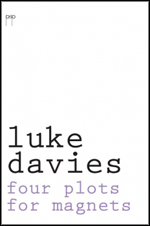
four plots for magnets by Luke Davies
Pitt Street Poetry, 2013
The original book with this title, containing 13 poems, was first published in 1982 in an edition of 300 copies. This version contains the original 13, plus another 53 previously unpublished poems from the same era, a foreword from the poet and an afterword from the original publisher, S.K. Kelen. This is more than a reissue or a new edition. It is a comprehensive collection of Davies’ works from the early 1980s and it is to be valued for the light it sheds on the development of one of Australia’s best regarded poets.
Poets, more than any other creative writers, have had to embrace technological change in the presentation of their works. From oral tradition, to ink on vellum, then paper, technology has had an influence on the forms of poetry. In the most recent past, small print runs forced economical solutions, and Davies writes about these in his foreword in regard to the first ‘version’ of this book. In the afterword, Kelen writes about the ‘‘guerrilla’ publishing unit’ Glandular Press, the imprint under which the book was first published as well as other experimental poetry publishers in Sydney in the early 1980s. The new edition, now with a spine and perfect bound in a white wrap-around cover, is grand, traditional even, but it should not be overlooked that print-on-demand and digital production methods lie behind the flattering look and feel of the new book. The original poems were hand-written in a notebook. So much can happen in 30 years.
Inside, the poems are printed on solid cream stock, 100 or perhaps more gsm. As Davies acknowledges, they were written when he was in his late teens and early twenties. He has chosen to leave them much as they were written, except to fix some punctuation and capitalisation that offends his older self. Many of the additional poems included have never been published before, but after 30 years they still stand up, even slight works such as ‘Fantastic’, which first features a quote from The Twilight Zone ‘… and his face was hot as blood …’ then continues:
& he feels great: but is it just the moon? (p. 40)
‘The gunpowder plot’, a poem from the original book, reads in 2013 as a foretaste of a world where terrorists inflict their horror:
That is why vision is clear in a bubble, and we do not try to hear (p. 20)
The themes and memes that repeat are drugs, other poets, a European – particularly French – rather than an Australian sensibility, an Indian influence and, surprisingly for a poet of this age, a lack of physical love. Perhaps that is why these works withstand scrutiny now as then. The poems I wrote at 20 were full of lust and yearning and excruciatingly embarrassing to read again. These poems, in the main, delight with their playfulness of language, rhythm and rhyme. They allow us to see a young poet flexing his lyrical muscle, and the graceful athleticism revealed gives as much pleasure as watching a dancer execute all the difficult steps without fault.
The original four plots for magnets is claimed by Pitt Street Poetry to be ‘one of the rarest and most collectable poetry artefacts of the early eighties’. That’s a mighty statement for a book with a print run of only ever 300 fragile, 22-page copies, staple bound and delivered by hand to a few inner-city bookshops and sold direct to communes of Surry Hills poets. However, this new version amply supports such a claim. The original poems and the 53 others that accompany them show how he began. Yes, there is a degree of pretentiousness, but no more than might be expected from any young poet proud of his or her ability to play with poetic forms.
The quatrains of ‘Drugs’, for instance, space out (my pun) levels of youthful experimentation in both chemical and poetic terms, but not always in ways I have observed. Take as an example:
Smack (the Big One): improves personality and wit. (p. 62)
This book deserves a place on the shelf and should be dipped into regularly. As an artefact, I enjoyed turning the beautiful paper of its pages and holding its textured, white cover. These poems could have been made available online or as an ebook only, and still been of interest. In this form, though, they are a work of art.









